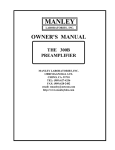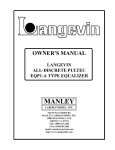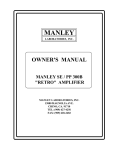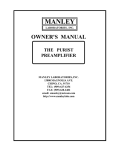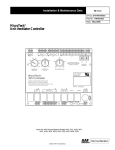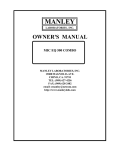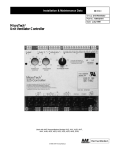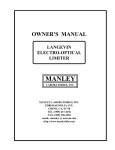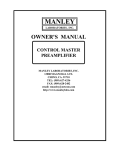Download Manley 75/150 SE/PP 807 MONOBLOCK Owner`s manual
Transcript
MANLEY LABORATORIES, INC. OWNER'S MANUAL 75 / 150 SE / PP 807 MONOBLOCK MANLEY LABORATORIES, INC. 13880 MAGNOLIA AVE. CHINO, CA. 91710 TEL: (909) 627-4256 FAX: (909) 628-2482 email: [email protected] http://www.manleylabs.com CONTENTS SECTION PAGE INTRODUCTION 3 READ THIS PAGE 4 MAINS CONNECTION 5 CONNECTING YOUR AMPLIFIER 6 DIAGRAM 2 7 TOP PANEL BIAS PROCEDURES 8 SPECIFICATIONS 9 WARRANTY 10 WARRANTY REGISTRATION 11 INTRODUCTION THANK YOU!... for choosing the Manley 75 / 150 SE / PP 807 MONOBLOCK Amplifiers. Designed by David Manley, the 807 MONOBLOCK Amplifiers use only the best available components, with the shortest and cleanest signal path possible. These amps have the exclusive Manley ability to switch from Single ended to Push-Pull topologies. This amp is designed to provide our customers with a the unique combination of single ended triode topology, solid power and remarkable specs. This includes flat frequency response, low distortion and optimum damping factor that are uncommon for single ended designs. In Push-Pull mode there is more of everything - double the power (150 watts), extended frequency response, and higher damping factor. Let us start out by stating our opinions about amplifier topologies. Historically, we have been manufacturing very highly regarded tube amplifiers since before tubes were considered the best option for hi-fi music reproduction. We have manufactured a very wide range of amplifiers with power ranging from 18 watts to 1000 watts and with a corresponding variety of tubes. This is not our first amp to feature 807's nor our first single ended triode amp. We build a $15,000 25 watt single ended amp on a custom basis. In our experience, the more power an amplifier is capable of - the better it will be at providing acceptable low frequency quality. It is not easy to produce a very powerful amp with highs with the same quality as the lows. To do that we had to start manufacturing our own transformers. This is the major development that allowed us to produce an amplifier that could switch from single-ended to push-pull. We had to design and build a very unusual transformer first. When several other manufacturers started selling single-ended amps with 5 to 9 watts of power, we understood subjectively and objectively the good part of the story - the superb mid range - the delicate transient detail - the inherent simplicity. The bad news was that there were almost no speakers efficient enough to be a dynamic viable system. The worst news was that either these single-ended amps cost more than the condo and/or they had specs that could only be a joke. As the triode fans increased, more efficient speakers became available and several fanatics began to dismiss push-pull as a bad thing to be avoided at all costs. We objected to such blanket generalities and stressed that the push-pull done right with truly balanced transformers, quality parts throughout and well designed circuitry has proven to be a superb technique. We also like single ended amps, but only when it is done right, mostly because we demand flat frequency response and low distortion out of an amplifier. We set out to design an amplifier that would appeal to us and to you and to the critics. It would be single-ended but with more power than most single ended amps. It would be switchable to push-pull for fans of that school and for those who want it both ways - to compare for themselves, and to use each mode depending on the music. This was the SE / PP 300B amplifiers. We recieved such great response to it that we followed it up with this 8 X 807 based gem that would appeal to people who need reasonable power for their speakers (average sensitivity) and listening levels (including rock). Up to now, they have had no option of using single ended triodes without trading in their favorite speakers. We are proud of these amplifiers and have been featuring them at hi-fi trade shows and exhibitions. There are other benefits to being an owner of an 807 based amplifier. A prime advantage is that these tubes are some of the most reliable we have experienced - plus these tubes are readily available and not extremely costly. These amplifiers have a highly polished look thanks to the gold and chrome finishes. These new metal technologies were not available a few years ago. Built to last a lifetime. Designed to look elegant. Engineered by David Manley who happens to love music enough to be his lifes career. READ THIS PAGE BEFORE YOU SET UP THE AMPS, PLEASE IMPORTANT Never operate this amp without a speaker or load connected. Never drive this amp into a short circuit. Most solid state amps can be operated without a load or speaker and some can drive a short circuit because of protection circuitry. These are different - Like most tube amps the output power is less affected by changing the load impedance within the range of 4 to 16 ohms, however extremes like a short or open circuit are to be avoided. The result could be damage to transformers, tubes. The warranty does not cover this damage if it occurs. LOCATION & VENTILATION IMPORTANT - PLEASE PROVIDE A SAFE LOCATION, SUCH AS A LOCKED CABINET, IF THERE ARE CHILDREN OR PETS IN THE HOME. At the top of the 807 tubes is a ceramic connector. This connector typically carries 630 VOLTS DC when the amplifier is on and afterwards until the power supply discharges. With all the tubes in this is typically 30 seconds. If you have small children or pets, you should consider placing the amplifiers out of reach to prevent damage to the amplifier or damage to your small children or pets.While these end caps provide sufficient insulation while attached to the tube - there is a shock hazard if they are removed and children can remove them. Manley Labs can supply an optional "Cover" for these amps if needed. Besides the high voltage, there is another hazard - HEAT. A child, spouse or pet could get a mild burn by touching a hot tube. Tubes produce heat but not as much as a light bulb. Most people do not put exposed light bulbs on the floor but many audiophiles do put tube amplifiers on the floor. Beware that it may be possible to step on an amplifier in the dark or trip on a cable and fall on one. Shades of "Help! I've fallen and can't get up!". The other thing to be aware of is poor ventilation if the amp is on a carpet. There is ventilation holes in the bottom of the chassis that are essential for the long and healthy life of the amp. Ventilation is also important if they are put in a cabinet with a door. Allow a minimum of 2 inches of clearance on the top and sides of the amplifiers, such that a constant flow of air can flow. Do not place amplifiers directly on high pile carpet or any other surface that will block the ventilation vents underneath the amplifiers. Isolation from vibration is worth considering because this will help to reduce tube microphonic noise and very likely allow the maximum sonic potential that these amps are capable of. Lastly, be aware that some equipment can radiate a strong electromagnetic field. Hum and noise problems are often cured by avoiding stacking electroic gear on top of each other. Distance helps greatly. GENERAL NOTES WATER & MOISTURE As with any electrical equipment, these amplifiers should not be used near water or moisture. If liquid enters the amplifier, it must be immediately returned to your dealer for servicing. SERVICING The user should not attempt to service the amplifier beyond that described in the owner's manual. Refer all servicing other than biasing and tube replacement to Manley Laboratories SPECIAL NOTES Before turning the amps on - Connect your preamp to the amp inputs. Tubes may become loose during transit. Straighten and press down each tube before plugging the amplifier into the mains socket. Once connections are secure turn the preamp on, wait a minute, turn the power amps on last. Always turn the amplifiers off first, then other gear. This prevents damage to equipment - particularily speakers. Furthermore, do not touch the tubes after the amplifier has been switched on, as the tubes become very hot during operation and should only be handled after the power has been turned off and the tubes have cooled. WARNING! TO PREVENT THE RISK OF ELECTRIC SHOCK DO NOT OPEN THE CABINET. REFER SERVICING TO QUALIFIED PERSONEL. MAINS CONNECTIONS Your amplifier has been factory set to the correct mains voltage for your country. The voltage setting is marked on the serial badge, located on the rear panel. Check that this complies with your local supply. Export units for certain markets have a moulded mains plug fitted to comply with local requirements. If your unit does not have a plug fitted the coloured wires should be connected to the appropriate plug terminals in accordance with the following code. GREEN/YELLOW BLUE BROWN EARTH NEUTRAL LIVE terminal terminal terminal As the colours of the wires in the mains lead may not correspond with the coloured marking identifying the terminals in your plug proceed as follows; The wire which is coloured GREEN/YELLOW must be connected to the terminal in the plug which is marked by the letter E or by the safety earth symbol or coloured GREEN or GREEN and YELLOW. The wire which is coloured BLUE must be connected to the terminal in the plug which is marked by the letter N or coloured BLACK. The wire which is coloured BROWN must be connected to the terminal in the plug which is marked by the letter L or coloured RED. DO NOT CONNECT/SWITCH ON THE MAINS SUPPLY UNTIL ALL OTHER CONNECTIONS HAVE BEEN MADE. CONNECTING YOUR AMPLIFIER Setting up your amplifiers is rather easy. 1. Connect all source components (turntable, CD, Tuner, Tape DAT, etc.) to your preamplifier or switching center. 2. Connect the interconnects from the output of the preamplifier to the RCA input on the top rear of the amplifiers. 3. Connect the hot or "+" speaker cable to the red binding post and the common or "-" speaker cable to the black binding post (See diagarm 2). Ensure that the other end of the cable is connected correctly to the speaker. Tighten the binding posts by hand. If you use a nut-driver (3/8") do not over-tighten the posts or you may break the connections inside the amplifier. 4. Ensure that the "mains" switch on the front panel is in the "off" or "0" position. If the 807s are not inserted - do it now - . 5. Turn on Preamplifier and any source components you plan to use. 6. Plug Amplifiers into wall outlets. 7. Set both amps up at the same SE or PP settings. SE is a good place to start. 8. Switch the square mains power switch to the ON or "1" position and allow the amplifier a minute or so to 'warm up'. The glowing panel and glowing tubes will indicate that the amplifier is on. 9. Turn up the volume on the preamp and enjoy. If something is "humming" don't panic. All you need to do is use a "3 pin to 2 pin AC adapter" or "cheater". The problem is too many grounds - you should only have one. Check out the next section for help with hum. 10. Now, while music is playing, try switching to PUSH / PULL. The difference may or may not be subtle. Choose the mode you like best with this music. There may be a distressing "click" as you switch - this is normal. GROUNDING and POWER: In the event of HUM we suggest that you alter the ground scheme. Electronic gear often has 3 pin grounds for safety reasons and international regulations. Unfortunately audio equipment is also prone to sensitivity to ground loops. The usual cure is to use 3 pin to 2 pin AC adapters availble at most hardware stores for about a dollar. Do not break off the AC ground pin. With the power off, try an adapter on ONE of the amps. If you have other units such as preamps or CD players with 3 pin AC plugs, use adapters here as well. The goal is to have ONLY ONE piece of equipment connected to AC ground via AC plugs. Other gear is grounded via the RCA interconnects. Only after all connections have been made should you turn on the power with the amplifiers being last on and first off always. A different alternative is to ground the preamp and to use adapters on every other piece of gear with 3 pin AC plugs. Alas, few preamps have AC ground pins. A third alternative is to use "balanced AC" (60-0-60) transformers to power all the equipment. The latest revision of the USA electrical codes allows this as a "legal" technique. It works very well at reducing many types of noise 10 to 15 dB. MANLEY 75 / 150 SE / PP 807 TRIODE MONOBLOCK A B C D E F G M 1234 H 2 K A B C D E F G H I J K L M N H 5 H 4 H 1 2 H 7 J H 3 1 5678 H 6 I 3 4 N 5 Amplifier Overhead View 6 H 8 7 8 L RCA Input Jack Speaker Terminals B PLUS FUSE - Replace only with same type and value (MDL 1.5) Mains fuse - Replace only with same type and value IEC Mains socket Output Transformer Power Transformer Power Tube 807 s Input Tube 5751 Driver Tube 7044 Single-Ended / Push- Pull Switch Power Switch Bias Adjustment Trimmers (each 807 has a trim and test point numbered) Bias Test Points (Black test point is Ground) REPLACING FUSES & LAMPS The fuses are accessable without removing any panels. Be sure the IEC AC power cable is removed before checking the Mains Fuse. Often a bad fuse will look blackened internally but occasionally will look OK. Replace only with the same type and rating ! For 100 or 120 volt countries the fuse should be a 10 AMP SLO-BLO. For 220 or 240 volt countries it should be 5 AMP SLO-BLO. If a new fuse blows then it is likely there is another problem. Remove the 807s and try again. If the indicator lights, then a tube is bad. At least one of them is the problem.If the fuse blew again - The amplifier needs to be repaired by a competent technician or the factory. Before removing the B+ Fuse let the power supply fully discharge - this will take at least 1 minute. The cap is removed with a proper sized screwdriver and 1/4 turn anti-clockwise while gently pressing down.The B+ Fuse we use is ceramic and not able to be visually checked - a VOM meter is needed. The symtom will be - lit indicators and glowing tubes but no sound. The indicator is a fuse style lamp 1.25" X .25", 8 volt, 0.3 amp. The bottom must be removed to access the lamp. Again, wait until the supply discharges. BIAS ADJUSTMENT TRIMMERS See the next page for full details - Read the voltage between the black test point and each of the numbered red points. If the reading is not 0.340 volts or 340 mV then adjust the corresponding numbered trimmer. OPERATIONAL NOTES SWITCHING SINGLE-ENDED 75 / PUSH-PULL 150 This amplifier has a feature exclusive to Manley Labs of being able to choose between two circuit topologies. You are able to switch between each mode while the amplifier is turned on and playing music. In SINGLE-ENDED mode the amplifier uses eight 807s in parallel. The advantage is a minimalist circuit requiring no "phase splitter",The disadvantage is a less efficient circuit that produces half the power of PUSH-PULL. In PUSH-PULL mode each tube works in opposite phase to the other and relies on the output transformer to make the polarities work together. This has advantages in efficiency and in the distortion and noise cancellation properties of a balanced circuit. Both ways are operated in "Class A" bias throughout and both are PURE TRIODE and both modes have a similar short signal path. ADJUSTING BIAS The amplifier has been factory adjusted and should not need adjustment more than once a month. This does more for tube life than it does for sound quality. You will need a DC voltmeter and a small flat screwdriver. This should be checked every few months but does not need to be necessarily adjusted unless an 807 pwer tube is replaced. Checking verifies that each tube is stable and operating properly. It may be the first hint that a tube is needing replacement. 1) Let the amp warm up in SINGLE-ENDED mode for about an hour, then with no music playing.... Set the volt meter to a low DC range such as 1 or 2 volts DC. 2) Put negative or black probe of the voltmeter to the black test point (ground),front and center of the amplifier and the red or positive probe in the small red socket most left front near the 807s. See the diagram on the previous page that indicates which test point and trimmer relates to which tube. 3) The meter should read 340 mV or 0.34 volts DC. If not -then you can adjust the trimmer without opening the chassis. It is located in the hole near the transformer and is blue. Adjust it gently and fairly slowly. A little "drift" is normal. 4) Now check and/or adjust the other tube's bias. Use the next right red probe socket and the next right trimmer and adjust the same way. Continue for all 8 power tubes. 5) You may want to re-check each tube's test point and re-adjust if needed. There may be some small interaction - particularly if a tube was replaced. TUBE LIFE You should expect many years of life from the tubes in your MANLEY SE / PP if you adhere to the procedures described above and check your bias at least once every 2-3 months. We stock all the tubes in these amplifiers should you ever need replacements (and at very reasonable prices too!) FUSES The fuses used in your amplifier are standard 1/4" x 1 1/4" SLO-BLO types. The correctly rated fuse has been installed at the factory for your country's voltage. If replacing a fuse, always unplug the amplifier's power cord from the wall outlet and always use the exact same type and ampere rating fuse as the one you are replacing. Failure to do so will void your warranty and can be a dangerous fire hazard. For 120 volts the correct fuses are MDL10 for the mains. For 240 volts the correct fuses are MDL5 for the mains. INDICATOR LAMP The lamp is a 1/4" X 1 1/4" fuse style rated at 8 volts and 0.3 amps. Power should be disconnected, the power supply discharged (1 minute). The bottom panel will have to be removed, The lamp is clearly accessable directly behind the semi-translucent Manley logo panel. Gently pry out one end to remove the lamp for replacement. SPECIFICATIONS Vacuum Tubes: 8 x 807 (Output), 1 x 7044 (Driver), 1 x 5751 (Input) Output Power @ 3% THD SINGLE-ENDED: - 72 Watts PUSH-PULL: - 150 Watts Frequency Response +/- 1 dB (measured at 5 watts) SINGLE-ENDED: 18 Hz - 20 KHz PUSH-PULL: 10 Hz - 50 KHz Input Sensitivity 1 V nominal Input Impedance 40 KOhm Load Impedance 4 to 12 Ohm appropriate for 4 & 8 ohm speakers 12 to 20 Ohm appropriate for 16 ohm speakers S/N ratio @ 33 watts Typically 86 dB or a -76 db noise floor 10Hz-30K Power Consumption 250 Watts Mains Fuse 100, 110, 120V 220, 240 V Lamp 1/4 X 1 1/4 Fuse lamp - 8 volt, 0.3 amp Dimensions W=19", D=13", H=8" inches Shipping Weight 75 lbs EACH 10 A (Slo-Blo) 5 A (Slo-Blo) WARRANTY All Manley Laboratories equipment is covered by a limited warranty against defects in materials and workmanship for a period of 90 days from date of purchase to the original purchaser only. A further optional limited 5 year warranty is available to the original purchaser upon proper registration of ownership within 30 days of date of first purchase. Proper registration is made by filling out and returning to the factory the warranty card attached to this general warranty statement, along with a copy of the original sales receipt as proof of the original date of purchase. Only 1 card is issued with each unit, and the serial number is already recorded on it. If the warranty registration card has already been removed then this is not a new unit, and is therefore not warranted by the factory. If you believe this to be a new unit then please contact the factory with the details of purchase. This warranty is provided by the dealer where the unit was purchased, and by Manley Laboratories, Inc. Under the terms of the warranty defective parts will be repaired or replaced without charge, excepting the cost of tubes. No warranty is offered on tubes, unless: 1. a Manley Laboratories preamplifier is used with a Manley Laboratories amplifier, and 2. the warranty registration card is filled out. In such a case a 6 month warranty on tubes is available with the correct recording of the serial number of the preamplifier on your warranty registration card. If a Manley Laboratories product fails to meet the above warranty, then the purchaser's sole remedy shall be to return the product to Manley Laboratories, where the defect will be repaired without charge for parts and labour. The product will then be returned via prepaid, insured freight, method and carrier to be determined solely by Manley Laboratories. All returns to the factory must be in the original packing, (new packing will be supplied for no charge if needed), accompanied by a written description of the defect, and must be shipped to Manley Laboratories via insured freight at the customer's own expense. Charges for unauthorized service and transportation costs are not reimbursable under this warranty, and all warrantees, express or implied, become null and void where the product has been damaged by misuse, accident, neglect, modification, tampering or unauthorized alteration by anyone other than Manley Laboratories. The warrantor assumes no liability for property damage or any other incidental or consequental damage whatsoever which may result from failure of this product. Any and all warrantees of merchantability and fitness implied by law are limited to the duration of the expressed warranty. All warrantees apply only to Manley Laboratories products purchased and used in the USA. Some states do not allow limitations on how long an implied warranty lasts, so the above limitations may not apply to you. Some states do not allow the exclusion or limitation of incidental or consequential damges, so the above exclusion may not apply to you. This warranty gives you specific legal rights and you may also have other rights which vary from state to state. WARRANTY REGISTRATION We ask that you please fill out this registration form and send the bottom half to: MANLEY LABORATORIES REGISTRATION DEPARTMENT 13880 MAGNOLIA AVE. CHINO CA, 91710 Registration entitles you to product support, full warranty benefits, and notice of product enhancements and upgrades. You MUST complete and return the following to validate your warranty and registration. Thank you again for choosing Manley Laboratories. MODEL ____________________ SERIAL No. ______________________ PURCHASE DATE ______________ SUPPLIER ______________________ --------------------------------------------------------------------------------------------------PLEASE DETACH THIS PORTION AND SEND IT TO MANLEY LABORATORIES MODEL: MANLEY SE / PP 300B MONOBLOCK SERIAL No. ______________________________ PURCHASE DATE ______________ SUPPLIER _______________________ NAME OF OWNER _______________________________________________ ADDRESS ______________________________________________________ CITY, STATE, ZIP ________________________________________________ TELEPHONE NUMBER ___________________________________________ Comments???? ___________________________________________________ ________________________________________________________________











